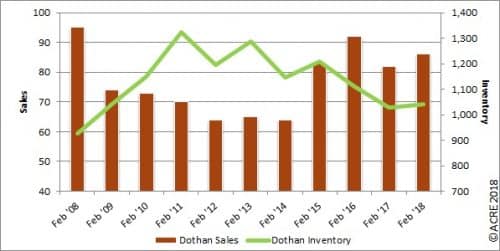Dothan February home sales rise 5 percent from last year

The Dothan-area median home sales price during February was $154,250, an 11 percent increase from February 2017. (file)
Click here to view or print the entire monthly report compliments of the ACRE Corporate Cabinet.
Sales: According to the Dothan Multiple Listing Service Inc., Dothan-area residential sales totaled 86 units during February, up 4.9 percent from the 82 units sold in February 2017. The five-year average for total residential sales during February is 77 units. Two more resources to review: Quarterly Report and Annual Report.
For all of Dothan’s area real estate data, click here.

Forecast: Closed transactions in February were 13 units or 13.3 percent below the Alabama Center for Real Estate’s (ACRE) monthly forecast.
Supply: The Dothan-area housing inventory in February was 1,042 units, an increase of 1.4 percent from February 2017. February inventory was the same as January inventory. Historical data indicates that February inventory on average (2013-2017) decreases from January by 17.6 percent. The five-year average for total homes listed during February is 1,156 units.
Demand: February residential sales in the Dothan area decreased 4.4 percent from January. Historical data (2013-2017) indicate that February residential sales on average decrease by 2.8 percent from January. Homes selling in the Dothan area during February averaged 164 days on the market, an 11.4 percent decrease from February 2017’s average of 185 days on the market.
Seeking balance: The inventory for sale divided by the current monthly sales volume equals the number of months of supply. The market is considered to be in balance at approximately 6 months of supply. The Dothan area has 12.1 months of supply, up from 11.6 months in January and down from 12.5 months in February 2017.
Pricing: The Dothan-area median sales price during February was $154,250, an 11 percent increase from February 2017 and a 10.5 percent increase from the prior month. Historical data indicate that February median sales prices on average (2013-2017) decrease by 23.7 percent from the month of January. Differing sample sizes (number of residential sales of comparative months) can contribute to statistical volatility, including pricing. ACRE highly recommends consulting with a local real estate professional to discuss pricing trends, as they will vary from neighborhood to neighborhood.
Industry perspective: The 10-year treasury is a crucial indicator of economic expansion. As of March 1, 2018, the 10-year treasury stood at 2.88 percent, a slight increase from last month’s rate of 2.86 percent. Mortgage rates also experienced a slight increase recently as the current rate on a 30-year fixed-rate mortgage is 4.57 percent, up from 4.38 percent one month ago. As the economy continues to strengthen, people will have more money in their pockets with the intent to spend. This increase in spending will most likely create higher stock prices and lower bond prices. With this increase of confidence in the market, mortgage interest rates can be expected to increase.
The National Association of Home Builders (NAHB) produces economic analyses of the home-building industry based on government data. The Housing Market Index (HMI) depicts market conditions for the sale of new homes. The HMI ranges from 0 to 100; a rate greater than 50 represents good sales conditions.
The HMI in the South has stayed relatively steady in the past few months with a score of 73. However, the HMI is lower in some regions of the United States, such as the Northeast, which has a rate of 56. The West has a higher HMI of 77, and a better market for good housing conditions.
The Federal Housing Finance Agency uses the House Price Index (HPI) to measure the average price changes in repeat sales or refinancing on the same properties. The FHFA’s national HPI was up 6.7 percent from the previous year compared to Alabama, which has increased from the previous year by 5.6 percent. The HPI rose in all 49 states except for Mississippi.
Compared to the national housing market conditions, Alabama’s real estate market has been showing improvement. Although total residential sales in Alabama decreased 2.3 percent from January 2017, the statewide median sales price increased 2.3 percent from January 2017. Statewide, homes in Alabama are selling much more quickly than in recent years as the average days on the market decreased 19.6 percent from one year ago.
Click here to generate more graphs from Dothan’s January Housing Report, including Total Sales, Average Sales Price, Days on the Market, Total Inventory and Months of Supply.
The Dothan Residential Monthly Report was developed in conjunction with the Dothan Association of Realtors to better serve area consumers.





